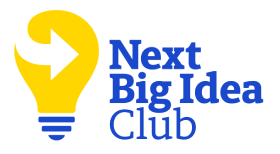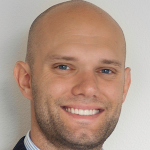Emily Falk is a Professor of Communication, Psychology, and Marketing at the University of Pennsylvania, where she directs the Communication Neuroscience Lab and the Climate Communication Division of the Annenberg Public Policy Center. Her work has been covered in the New York Times, Washington Post, BBC, Forbes, and Scientific American, among other outlets.
What’s the big idea?
Every moment is filled with how we’ve decided to spend our time, and that time defines us. We make value judgements (often automatically) of our options and follow similar patterns, day in and day out. When we decide we want to change in some way, it can be extremely difficult to snap out of our typical decision-making to opt for something else, even if we genuinely care about living differently. By understanding how the brain calculates values to drive daily decisions, we can learn how to explore paths that are more aligned with new goals and evolving self-image. By expanding the power and possibility of our choices, we increase the capacity for inner, societal, and cultural growth.
Below, Emily shares five key insights from her new book, What We Value: The Neuroscience of Choice and Change. Listen to the audio version—read by Emily herself—in the Next Big Idea App.
1. Our brains shape what we value.
Neuroscience research (first in monkeys and then in humans) has shown that a network of brain regions, known as the value system, computes our daily choices in a process called value calculation. This happens whether we’re aware of it or not.
Each choice we make is first shaped by what options our brain considers. When I imagined choosing between a run or doing extra work, other options like heading to a karaoke bar with my coworkers or going for a walk with my grandma rarely entered the calculation. In the next phase of decision-making, the value system assigns a subjective worth to each choice based on our past experiences, current context, and future goals. Going for a run is hard. It’s the end of the day, and I’m already tired. Sure, the run would be good for my health, but look how many unread emails there are…so I choose to finish up the emails.
After we choose, the value system keeps track of how things went, making us more likely to repeat choices that were more rewarding than we expected and less likely to repeat choices that were less rewarding than we expected. After choosing the work, my body felt kind of blah, but my students were making progress on interesting problems, and that felt good.
The value our brains assign to different options is dynamic and can shift depending on context, like what mood we’re in, what other people are saying or doing, and which parts of the choice we pay attention to. Understanding this can help us identify opportunities to change, and ways to align choices with our bigger-picture goals and values. For me, I knew I needed to find a way to make moving around and spending time with people I love more compelling to my brain in the moment.
2. Our brains shape—and limit—who we are.
Our sense of who we are is an important factor in shaping our choices. Neuroscientists have identified brain regions that help construct our sense of “me” and “not me,” and when we make decisions this self-relevance is deeply intertwined with the value system. Together they guide us toward choices that are aligned with our perceptions of who we already are.
“We tend to favor choices that reinforce our existing identity, sometimes at the cost of new opportunities and experiences.”
Having a coherent sense of who we are can be useful, but it also limits us. We tend to favor choices that reinforce our existing identity, sometimes at the cost of new opportunities and experiences. When I kept choosing work, my identity as a hard-working researcher who always hits deadlines and invests in mentoring students weighed heavily on my value calculations. I didn’t think of myself as an athlete, and in the process, I deprived myself of chances to improve as a runner, dancer, or any number of other options.
A mountain of research data shows that I’m not alone in this. Most of us cling to ideas and behaviors we consider “ours,” a phenomenon called the endowment effect. Sometimes, this helps us affirm our core values and reinforce choices that are compatible with longer-term goals, but it can also leave us with a bounded notion of self, meaning that it limits the way we see ourselves. When confronted with evidence that our past behaviors weren’t optimal, or that others want us to do things differently, it can make us defensive, leading us to double down on past choices, which can make change harder.
When my grandma told me that she wished we could spend more time together, I barely let her finish the sentence before defensively explaining that of course we spent time together—she’d come to my house and hang out with my kids while I cooked dinner, and often we’d even steal a few minutes to walk around the block together. But, no, she patiently explained, that was not what she was after. It wasn’t until later when I was able to think about what really matters to me that I could see that what she was asking for was something that I wanted too.
3. We don’t decide alone.
Neuroscientists have identified brain regions that help us understand what other people think and feel. The brain’s social-relevance system helps us connect and coordinate with other people, also shaping the decisions we make. Our sense of what others are doing or thinking strongly affects what we choose, what we’re willing to change, and the possibilities we consider.
Feeling a sense of status, belonging, and connection serves as a powerful reward, and we often make choices shaped by these forces. When I imagined what other researchers were doing, I imagined them hard at work making progress—not going for runs or walks with their grandmas. It was important to me to be seen as a serious scientist. When I imagined my collaborator’s appreciation of my speedy email replies and my students’ gratitude for timely feedback, the decision to keep working made even more sense.
“Feeling a sense of status, belonging, and connection serves as a powerful reward.”
But, although the social relevance system can help us understand others, it can also mislead us. I was imagining what others would think and feel if I left work, and my social relevance system was very convincing, even though in reality, I didn’t actually know. I had never fact-checked those assumptions. The same can be said when our social relevance system paints such a vivid picture that we feel certain we know why a co-worker didn’t invite us to lunch or why our spouse is frustrated.
By keeping us aligned with others, the social relevance system can do useful things like keep us current on trends. Or it can do harmful things like deluding us into agreeing with popular but patently false social media posts. It also shapes what we think is acceptable and desirable regarding whether we should spend a beautiful autumn afternoon at the office or on a jog.
4. We can work with our brains to create change.
Many of us have been taught that hard work and pain are necessary for achievement. Theodore Roosevelt went so far as to suggest that “Nothing in the world is worth having or worth doing unless it means effort, pain, difficulty…” But neuroscience research highlights that small shifts in how we frame decisions can change our value calculations. My hope is that understanding how this works might make change easier.
Our value system serves as the bridge between where we are now and where we want to be, and the self- and social-relevance systems shape what we value. If we want to change ourselves, the people we care about, or even society, we need to harness these systems and leverage key ingredients for change, such as shifting focus, letting go of defensiveness, and expanding where the inputs to our value calculations come from in the first place.
Based on what we know about the brain’s value system, we can shift our focus to different aspects of a situation to align our emotions with our objectives. For instance, we can leverage the brain’s natural tendency to prioritize immediate gratification to make future-oriented choices feel more rewarding in the present. Instead of choosing between immediate and future rewards, we can find ways to bridge them.
Returning to the whisper in the back of my mind, reminding me to spend more time with my grandma, I knew I needed to find a way to make walks with Grandma Bev compatible with the other immediate pressures factoring into my value calculations. One day, walking home from work, a podcast episode created a small bridge in my thinking. The episode of How to Save a Planet highlighted the joy of biking. What if, instead of driving to Bev’s, arriving stressed from the traffic and struggling to find parking, I biked? What if I had some time to myself outside and got some exercise on the way? The immediate reward of checking something off of my work to-do list was offset by the opportunity to enjoy a bike ride in addition to the reward of spending time with my grandma. Hearing these regular people on the podcast teetering around on bikes also made me think that I could be that kind of person too.
“We can shift our focus to different aspects of a situation to align our emotions with our objectives.”
There was still the issue of not wanting my grandma to be right when she pointed out that we weren’t spending much quality time together. Should I admit I was wrong? Using what we know about the self-relevance system, to combat defensiveness, we can focus on “self-transcendent values,” which focus on the things that matter most to us. Zooming out like this to focus on our core values, or the well-being of others and the world, allows us to see that being wrong about something doesn’t have to mean we’re a bad person, or that everything about us has to change. We can hold onto a core sense of self while opening ourselves to changing what’s not working and letting go of preconceived notions of who we are.
Finally, turning to the social relevance system, the people who most immediately come to mind when we make choices get an outsized influence. When I was thinking about the people I spent my days with at work, it made work rewards salient. And this isn’t just true when it comes to decisions about how we spend our afternoons. All kinds of decisions, from the products we buy to what we think is important politically, are shaped by the voices we imagine most readily. Research shows that the people we spend time with are often similar to us in many ways.
To counteract known biases in the social relevance system, we can audit who is and isn’t part of our social networks and actively bring in new ideas through what we read, listen to, and spend time with. This expands our universe of choices, provides new and unexpected perspectives, and improves our ability to come up with creative solutions to problems.
5. Shaping the future starts in our minds.
Our choices don’t just shape our own lives; they ripple outward, influencing culture and collective values. Research shows that norms are deeply shaped by those around us.
Just as observing others influences our value calculations, we serve as role models for the people who see what we do. In this way, our own value calculations influence the people around us. When I share stories about my grandma with my students and colleagues, I’m not just telling them about my family. I’m opening a possibility for them to prioritize spending time with their loved ones.
Consciously and unconsciously, our actions change what others value. The ways we see ourselves can influence what is possible for others, and what we think is possible shapes the culture of the future.
Enjoy our full library of Book Bites—read by the authors!—in the Next Big Idea App:










